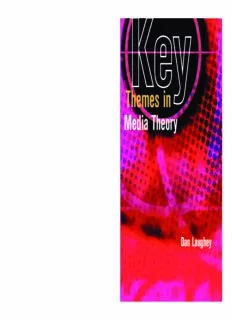
Key Themes in Media Theory PDF
Preview Key Themes in Media Theory
Key Themes in Media Theory “Key Themes in Media Theory is wonderfully wide-ranging and deservedly destined to become a key text for students of Media Studies.” Professor John Storey, Centre for Research in Media and Cultural Studies, University of Sunderland, UK K e What is media theory? y T How do media affect our actions, opinions and beliefs? h e In what ways do media serve powerful political and m Themes in economic interests? e s Is media consumerism unhealthy or is it empowering? i n Key Themes in Media Theoryprovides a thorough and critical introduction M to the key theories of media studies. It is unique in bringing together different e Media Theory d schools of media theory into a single, comprehensive text, examining in depth i a the ideas of key media theorists such as Lasswell, McLuhan, Hall, Williams, T Barthes, Adorno, Baudrillard and Bourdieu. h e Using up-to-date case studies the book embraces media in their everyday o r cultural forms – music, internet, film, television, radio, newspapers and y magazines – to enable a clearer view of the ‘big picture’ of media theory. In ten succinct chapters Dan Laughey discusses a broad range of themes, issues and perspectives that inform our contemporary understanding of media production and consumption. These include: Behaviourism and media effects Feminist media theory Postmodernity and information society Political economy Media consumerism With images and diagrams to illustrate chapter themes, examples that apply D media theory to media practice, recommended reading at the end of every a n chapter, and a useful glossary of key terms, this book is the definitive guide L to understanding media theory. a u g Dan Laughey h Dan Laugheyis Senior Lecturer in Media Studies at Leeds Metropolitan e y University, UK. Designed By Grosvenor (Northampton) Ltd. KeyThemesinMediaTheory KeyThemes in MediaTheory DanLaughey Open University Press Open University Press McGraw-Hill Education McGraw-Hill House Shoppenhangers Road Maidenhead Berkshire England SL6 2QL email: [email protected] world wideweb: www.openup.co.uk and TwoPennPlaza, New York,NY10121–2289,USA Firstpublished 2007 Copyright #DanLaughey 2007 All rightsreserved. Except forthe quotationof short passagesfor the purposesof criticism andreview, nopart of thispublicationmay bereproduced, stored in a retrieval system, ortransmitted, inanyform orbyanymeans,electronic, mechanical,photocopying,recordingorotherwise,withoutthepriorpermissionof thepublisheroralicencefromtheCopyrightLicensingAgencyLimited.Detailsof suchlicences(forreprographicreproduction)maybeobtainedfromtheCopyright Licensing Agency Ltd of SaffronHouse, 6–10KirbyStreet, London, EC1N8TS. A cataloguerecord of thisbookisavailablefrom theBritish Library ISBN–10: 033521813X(pb) 0335218 148(hb) ISBN–13: 9780335218 134 (pb)9780335 218 141(hb) Library of CongressCataloguing-in-Publication Data CIP dataappliedfor Typeset byYHT Ltd,London Printed inPoland byOZGrafS.A. www.polskabook.pl Contents List ofillustrations ix Acknowledgements xi 1 Whatis media theory? 1 Whatare media? 1 Whatistheory? 3 Whatismedia theory? 4 How touse this book 5 2 Behaviourism and media effects 7 Introduction 7 Lasswell’s chain ofcommunication and propaganda technique 8 Wertham: Seductionof theInnocent 12 Cantril: TheInvasion from Mars 16 Cultivation theory 20 Agenda-setting and socialfunctions ofmedia 21 Two-step flow andthephenomenistic approach 23 Usesand gratifications theory 26 Summary 27 Further reading 28 3 Modernity and medium theory 30 Introduction 30 Innis:TheBias of Communication 31 McLuhan:themedium is themessage 33 Benjamin: art andmechanical reproduction 38 TheLeavises and theLynds 41 Riesmanand Hoggart: other-directed characterand its uses of literacy 44 Williams: technology and cultural form 46 Habermas: mediaand thepublic sphere 48 Summary 52 Further reading 53 vi CONTENTS 4 Structuralism andsemiotics 54 Introduction 54 Saussure and Barthes: language and myth 55 Hall: Encoding/Decoding, ideology andhegemony 60 Glasgow Media Group: theideology of news 65 Williamson: theideology of ads 67 Morley: theNationwide audience 69 Hebdige: Subculture 71 Foucault: discourse and disciplinary society 73 Summary 76 Further reading 76 5 Interactionism and structuration 78 Introduction 78 Goffman: self-presentation 79 Meyrowitz: NoSenseof Place 84 Horton and Wohl:personae andpara-social interaction 86 Thompson: mediated quasi-interaction 88 Labelling theory and moral panics 91 Giddens: structuration theory 96 Summary 98 Further reading 99 6 Feminismsand gender 100 Introduction 100 Radical feminism 101 Mulvey: themale gaze 102 Modleski and Radway: mass-produced fantasies for women 105 McRobbie: theideology of teenagefemininity 107 Ang: pleasureand theideology ofmassculture 111 Butler: GenderTrouble 113 Postfeminism and thethirdwave 115 Masculinity in crisis 117 Summary 120 Further reading 120 7 Politicaleconomy and postcolonial theory 122 Introduction 122 Adorno: culture industry or cultural industries? 123 Media and cultural imperialism 127 Herman and Chomsky: ManufacturingConsent 130 Critical political economy 134 Said: Orientalism 138 CONTENTS vii ‘Thepostcolonial’ and race 142 Summary 144 Further reading 145 8 Postmodernity and theinformation society 147 Introduction 147 Baudrillard: hyperreality andsimulation 148 Boorstin and Debord: theimage and thespectacle 152 Jameson: pasticheand intertextuality 154 Lyotard: thedecline ofmetanarratives 157 Theinformation society 160 Ritzer: McDonaldization 165 Summary 167 Further reading 168 9 Consumerism and everyday life 169 Introduction 169 Fiske: consumerresistance 170 DeCerteau: everyday tactics 173 Textual poachersand fandom 176 Silverstone: thecycle of consumption and mediated experience 179 Thediffused audienceand consumer authority 182 Bourdieu: thehabitus and fieldtheory 186 Summary 192 Further reading 192 10 Debating media theory 194 Glossary 199 Bibliography 206 Index 223 Listofillustrations Figures 2.1 Lasswell’s chainof communication 9 2.2 WW1British propaganda courtesy ofGettyImages 11 2.3 Crime comic image 13 2.4 Agenda-setting roleof themassmedia 22 3.1 Characteristics of modernity andpre-modernity 30 3.2 Hot and cold media 34 3.3 Mona Lisa 39 3.4 Majorityand minority audiencesfor popular music 45 3.5 Habermas’s history of newsprintproduction 50 4.1 Syntagmaticand paradigmatic dimensions of semiotics 57 4.2 Saussure’s semiotic theoryof language 57 4.3 Barthes’s semiotictheoryof language and myth 57 4.4 The Encoding/Decoding model 62 5.1 Deviancyamplification model 93 5.2 Newspaperfront page courtesy of CorbisImages UK Ltd 95 6.1 Jackie front covercourtesy of Carlton Books 108 7.1 Horizontal integration 136 7.2 Vertical integration 136 7.3 The Westversus theOrient 139 7.4 Abu Hamza (aka CaptainHook),Islamic extremist courtesy of GettyImages 141 8.1 Postmodernity and theempowered masses:some reasonsfor the decline of modernismand elitist ‘highculture’ 148 9.1 Fiske’s twoeconomiesof television 171 9.2 Star Trek fanart courtesy of NewEye Studio 178 9.3 Silverstone’s cycleof consumption 180 9.4 Some occupational classifications basedon levelsof economic capital(EC) andcultural capital(CC) 188 Tables 3.1 McLuhan’s mediahistory ofmodernity 35 4.1 Homologies of youthsubcultures 72 8.1 Baudrillard’s threeordersof simulation 149 8.2 Radical differences betweentheindustrialand post-industrial societies 161
Description: